Fitbit Charge 3 Review
The best all round fitness band from Fitbit yet?
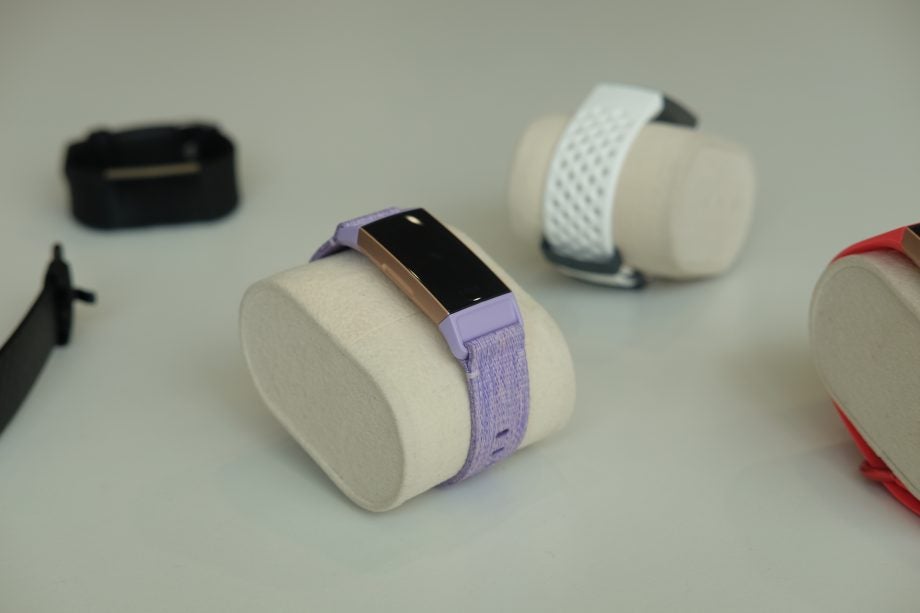

Verdict
The Fitbit Charge 3 corrects many of the shortcomings of its predecessor, making it one of the best fitness trackers for regular folk – even if you can find more feature-packed rivals.
Pros
- Attractive design
- Larger, sharper display
- Great battery life
- Well-presented app
- Water-resistant
Cons
- Some might miss built-in GPS
- Still waiting to use the SpO2 sensor
Key Specifications
- Review Price: £129.99
- Updated design
- Water resistant to 50m
- 7 days battery life
- Gorilla Glass 3 screen
- Sp02 sensors
- ‘Connected’ GPS
- 24/7 heart rate tracking
What is it?
Fitbit has always been a dominant force in the fitness tracking market, and a large part of that dominance can be attributed to its Charge series of trackers that have been its biggest sellers. The Charge models are now part of Fitbit’s mid-range offering, lacking the smartwatch functionality of its more expensive siblings like the Fitbit Versa, but still offering more in the way of smartphone connectivity and functionality than the entry-level Fitbit Flex 2 or Fitbit Alta HR.
The latest update, the Charge 3, isn’t a massive departure from last year’s Charge 2. But the improvements, like added water resistance and improved battery life, make a significant difference to everyday use. Together, these incremental improvements build upon the Charge 2’s already strong foundations.
It’s a great choice for those looking to take a more considered approach to their fitness, but not needing anything too advanced.
Design and connectivity
The Charge 3’s design is one of the many areas where these small changes have had a big impact. It’s a much sleeker device, and more comfortable to wear as a result, sitting flush against your wrist, even if the difference is marginal. Its case is made from aluminium rather than steel, so it’s 20% lighter.
Related: Fitbit Sense
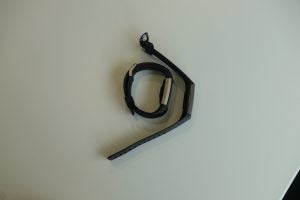
Fitbit Charge 2 (left) vs Charge 3 (right)
Wearing the Charge 3 day to day, it’s easier to forget it’s there. There’s an array of new straps available, including woven and more premium leather options. Personally, I like the new standard silicone strap. It feels inspired by the Fitbit Versa, and elevates even a basic black silicone strap to something that’s more fashionable.
The strap here has a patterned texture that catches the light ever so slightly, which makes it much less boring. This added flare was previously reserved for only the more premium Charge 2 straps.
A standard belt buckle is used for fastening. I like that the second loop holds the excess strap, so it doesn’t flap around during exercise or get caught on your sleeves – it’s the little things like this that matter, especially considering a fitness tracker is something you’re never meant to take off.
My one issue, which is also the case with many other silicone straps I’ve worn, is that it can get quite dirty. The material attracts the likes of lint, dust and crumbs from my lunchtime panini, so every now and then it needs a wipedown. As before, the straps pop off with quick-release catches, so you can swap them out to suit the occasion. I wouldn’t wear the leather options in the pool, for example.
Related: Best fitness trackers
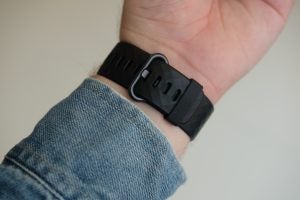
The strap is kept nice and neat and has a new patterned design
The biggest change in aiding the Charge 3’s ever-presence is the added water resistance to 50 metres. It’s been a bugbear of mine whenever a fitness tracker isn’t water-resistant. It’s not necessarily about anything like advanced swim tracking – I simply don’t want to worry about taking it off to have a shower or a casual dip in the pool.
Whenever you take a fitness tracker off, that’s one more chance you don’t put it back on. And each time you fail to put it back on is another chance it ends up in a drawer, sad and unloved. To really get any benefit from a fitness tracker, you need to build a routine of actually wearing it. So, having the convenience of being able to shower with the Charge 3 makes a big difference to your everyday experience.
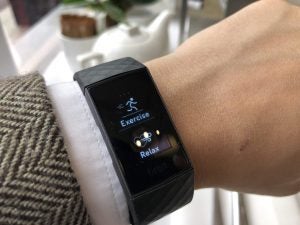
The menus are easy to navigate
To help facilitate this water resistance, the old side button of the Charge 2 is in fact no longer a physical button. It’s now inductive and gives you a little haptic vibration when you squeeze the edge of the device.
It functions the same way as the old side button, letting you back out of menus. But I actually much prefer this new version: it works reliably and the vibration still makes it feel nice and tactile.
Related: Fitbit Charge 4
While Fitbit increased the display fourfold with the Charge 2, it’s gotten bigger again for the Charge 3, without impacting the overall size. It’s now 40% larger, with an increased sharpness and brightness. The latter is good news for outdoor use.
The watch face and overall interface both make better use of the higher resolution display, showing richer information with larger fonts that are easier to read. The OLED-based display lets you tap and swipe your way around the menus and feels swift and responsive.
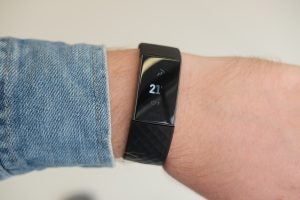
The bigger display is much easier to read at a glance
Like the Charge 2, the new Charge 3 can mirror your smartphone notifications to your wrist. Better yet, there’s no restriction on what apps can be mirrored as there was before.
Notifications make good use of the improved display, allowing more text to be shown on screen, so you can comfortably read incoming messages. If you’re on Android, you can soon use quick replies to respond to messages, too. Frustratingly, this is still absent on iOS, but that’s due to Apple and not Fitbit.
You also get a vibration when receiving an incoming call and can answer and reject calls from your wrist (although you’ll still need to whip out your phone to actually have a conversation). Disappointingly, there’s no music control from the Charge 3, which would have been useful, especially for anyone taking their phone along for a run.
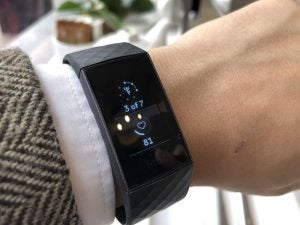
A swipe up shows you your day’s stats
Activity and fitness tracking
Not a lot has changed in terms of the sensors inside the Fitbit Charge 3, save for the addition of an SpO2 sensor that is also seen in the Fitbit Ionic and Fitbit Versa. This works alongside Fitbit’s PurePulse heart rate monitor to also track your blood oxygen levels.
Even though it was first debuted over a year ago, Fitbit is yet to actually make use of the SpO2 functionality. Fitbit is planning on using the extra data in its Sleep Score Beta programme in November, which aims to give you a better understanding of your sleep quality by using your breathing data overnight.
Otherwise, not much has changed from last year’s Fitbit Charge 2. The Charge 3 still includes the standard all-day activity tracking and sleep tracking overnight. That means it’ll count your steps and movement, and give you a nudge if you’re too sedentary. These alerts kick in if you’ve not taken at least 250 steps during your preset ‘active hours’ and serve as a nice bit of motivation to get away from your desk every now and then.
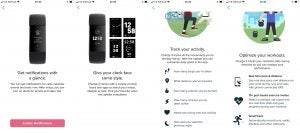
Setting up the Charge 3 gives you an overview of many of its features
There’s also automatic exercise detection for activities like longer walks, running and the elliptical machine, so you can just set off and not worry about manually starting a new workout. There’s a whole range of other exercises you can otherwise start from your wrist, including weight training and an interval timer useful for HIIT workouts.
New, thanks to that added water resistance, is swimming, which can be used to track laps and duration in the pool. The experience is very much like Fitbit’s other water-resistant trackers and it does a surprisingly good job of accurately counting out laps so you don’t have to.
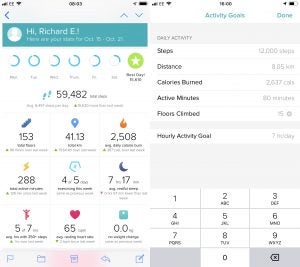
Setting goals is easy in the app, and you can also sign up for weekly emails detailing your stats for the week
Related: Best running watches
GPS still remains absent, which Fitbit has said is to keep the size and weight down. That feels a little like a cop-out, considering fitness trackers like the Garmin Vivosport manage to include GPS just fine and are still sleek.
But truth be told, I don’t really miss GPS. There’s no functionality for streaming music off the Charge 3, so chances are you’re going to bring your phone along for an outdoor workout to listen to music anyway. In this regard, the Charge 3 can use Connected GPS to piggyback the GPS from your phone for more accurate distance and pace tracking, so it’s not the end of the world.
I tried going for a run with the Charge 3, using just its accelerometer to estimate distance, compared with a GPS-enabled Fitbit Ionic I was wearing. The Charge 3 was off by almost a kilometre. That’s a little surprising, considering I found the Charge 3 managed to estimate distance so well.
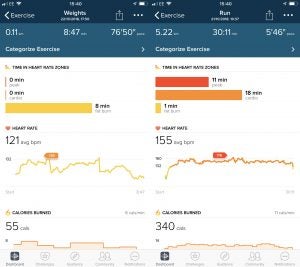
The exercise screen is pretty basic for a weights exercise or when you run without GPS
So if you want a more accurate record of your exercise, you’ll need to use that Connected GPS. You get the information you want, such as pace, distance and time, displayed from your wrist, and a swipe between screens lets you intuitively jump between them without having to interrupt your run.
The heart rate monitor is also fine for an average reading of your heart rate, only coming a few beats per minute off a Fitbit Ionic on my other wrist, and a Polar OH1 attached to my upper arm once the data was pulled into the Fitbit app.
But if you want more accurate heart rate readings in the moment, such as for HIIT or heart rate zone training, the Charge 3 shows its limitations. With quick sprints to get my heart rate up, the Charge 3 really lagged behind updating its on-wrist data, with the other two devices typically being 10bpm (beats per minute) higher until the Charge 3 caught up.

The exercise screen is pretty basic for a weights exercise or when you run without GPS
Otherwise, for things like step counting, everything seemed just as it should be. Setting a step or floors climbed goal and getting a buzz on my wrist to say I’ve hit it still remains a positive motivator, and going on multiple day exercise streaks still gives me a warm feeling inside.
The resting heart rate readings are also a great way to see your cardiovascular health improve over time. It’s these little things that Fitbit gets right, especially with its companion app where all of this data is well presented.
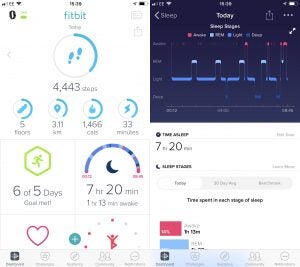
The Fitbit app does a good job of making your sleep data easy to understand
The sleep tracking, even without the previously mentioned Sleep Score Beta, remains one of my favourite implementations. Fitbit’s Sleep Stages makes it easy to understand how much time you spend in each sleep stage – Awake, REM, Light, Deep – with straightforward bar charts, averages and benchmarks against other people your age.
It has made me more aware of how poor quality my sleep can be and explained why I’m waking up tired even after the prescribed eight hours a night (I’ve cut my daytime caffeine consumption way down as a result and my resting heart rate has thanked me).
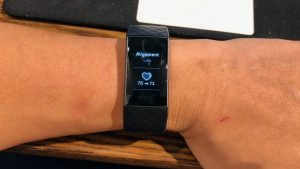
The guided breathing results screen now makes it feel useful
The guided breathing exercises also make a return, but now they use haptic feedback, so you know when to inhale and exhale without intently staring at the screen and breaking your feeling of tranquillity. That’s something I was crying out for in my Fitbit Charge 2 review.
You also get a screen at the end of the two or five-minute Breathe session to show the impact taking some time out of your busy schedule has on your heart rate. This goes a long way to make the feature feel more purposeful. Again, small improvement, big difference.
Battery life and charging
The other aspect that helps with reducing how often you take off a fitness tracker is battery life. It’s here that Fitbit has made another small but important improvement. Fitbit rates the Charge 3 as being able to last up to seven days on a single charge, and I’m pleased to say that it actually managed to surpass this.
Even during weeks where I’d tracked half a dozen runs and weights workouts, and worn the Charge 3 every day, it actually managed to make it to seven and a half days. Not needing to use its own GPS really helps with battery life for outdoor exercise.
That’s a big jump up from the five days I saw from the Charge 2 last year, and it makes the Charge 3 one of the longest-lasting fitness trackers with a screen that provides this much extra functionality.
The Charge 3 is charged using a USB cable with a proprietary clasp that securely locks onto its back. Not just using a magnetic lock means it’s a lot more fool-proof, so you shouldn’t come back to a tracker that’s not actually charged.
Related: Best Fitbit
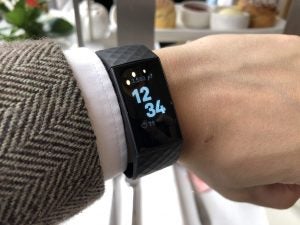
Why buy it?
If your relationship with fitness doesn’t need the fancy bells and whistles of more expensive fitness trackers and running watches, you’ll feel right at home with the Charge 3. Even while Fitbit is pushing smartwatches like the Versa and Ionic, it knows there’s still a market for more approachable fitness trackers that do the basics, and do them well.
In this regard, the Charge 3 is the most approachable of them all. It has a design that easily blends in and that is – dare I say it – actually quite attractive. The display has gotten bigger and richer in information, it’s now water-resistant and supports swim tracking, and the battery life has improved. Its launch price is also slightly cheaper than the Charge 2 at £129.99 versus £139.99.
Whether or not you’ll miss the built-in GPS is probably down to whether or not you plan on bringing your phone along anyway. If you do want GPS, the Garmin Vivosport is around the same price these days.
Fitbit has been doing this for so long that it’s now simply refining a well-established blueprint. It’s just a shame features like the upgraded Sleep Score are still in the pipeline.
Verdict
A great all-rounder that fixes the problems of the Charge 2.


